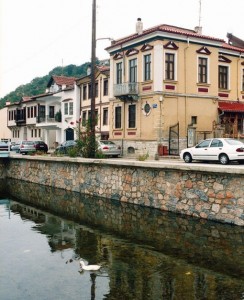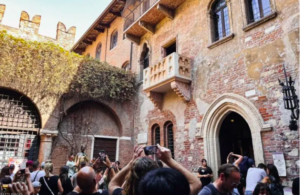An outstanding natural landscape dotted with six magnificent lakes (Vegorítida, Petrón Lake, Zázari, Ximarítida, Mikrí and Megáli Préspa), picture-perfect lakeside villages, stone-built villages and a beautiful capital traversed by a river: this is the prominent director’s Theo Angelopoulos favourite filmmaking spot, the place that inspired him deeply to praise beauty and life…
The city of Flórina experienced an outstanding cultural and economic uplift around 1893 due to its railway connection with Thessaloniki. This wealth is perfectly encapsulated in the eclectic early 20th century edifices. Start your tour around the city with a visit to the Archaeological Museum standing next to the Railway Station. One of the Station’s old buildings houses the Art Gallery that exhibits works of local artists. The landmark of the city is certainly its river, Sakoulévas, which one can walk along starting from Ioánnou Árti Street. On the left bank of the river you can gaze at the Second Primary School, the House of Tegos Sapountzís (the first Mayor of the City, 1912), the workshops of two local artists, the Modern Art Museum and the House of Voyiatzís, where many scenes of Angelopoulos film “The Beekeeper” were filmed. On the opposite side still stands the three-story “House of Péios”, one of the most impressive traditional mansions of Flórina. Continue your tour at the Dikeosínis (meaning Justice) Square, adorned with well-preserved public buildings, the old prison and the Turkish Baths. If you want to rest a bit, choose one of the hive cafes of Melás Pedestrian Street to indulge in a coffee or a delicious local specialty.
Don’t leave without having bought some of Flórina’s exquisite local products, such as Flórina red peppers, Préspes beans, mountain tea, spoon sweets and knitted candles made from skillful local candle makers. Last but not least, the ski aficionados can slide down snowy slopes at the Vígla Ski Center at the village of Pisodéri (19 km far from Flórina, at an altitude of 1.600-1900 m).
Note that all year round joyful events spread a festive alarm all over the city:
– Florina’s Fires at midnight on December 23rd at Eróon square.
– The Revival of the “Barbaria” custom on New Year’s Day.
– The “Leyístia” are held during the first ten days in August.
Préspes Lakes
Only 45 km west of Flórina, on the borders with FYROM and Albania, lies one of the most important habitats in Greece and the first transboundary protected area in the Balkans. The Préspes National Park is a wetland with rich bio-diversity, whose core covers an area of 4,900 Km2. The wealth of this bio-diversity is perfectly demonstrated by the fact that more than half of birds, amphibians and mammals species found in Greece are encountered here; besides, 9 out of the 23 fish species living in its waters are endemic. A large part of the Préspa National Park was also included in the NATURA 2000 network of protected areas. The Megáli (Big) Préspa Lake is the aquatic border between three countries, with its largest part belonging to FYROM. Its waters communicate with the waters of Mykrí (Small) Préspa, from which it is separated by a narrow silted strip of land. The Mykrí Préspa belongs almost exclusively to Greece, since the latter shares only a very small part of it with Albania; it also boasts two islets: Áyios Ahíllios and Vidronísi.
On the banks of Megáli Préspa you will encounter the traditional village of Psarádes, where you can admire traditional houses of Macedonian architecture. Indulge your palate in freshwater fish served by the lake-side tavernas. Rent a boat to take a cruise around the lake and admire the one of their kind “askitariá” (hermit cells) with their stunning 14th-15th century rock paintings. During the Ottoman Empire the natural beauty and isolation of the area attracted many monks who built their hermitages along the shore of the Lake.
South of Psarádes, on the NW side of Mykrí Préspa Lake, lies the islet of Áyios Acíllios, one of the most picturesque places in Northern Greece connected to the shore with a 650 m long floating bridge. It is of the inhabited islands on a lake in Greece, particularly renowned for its Byzantine monuments, among which stands out the three-aisled basilica of Áyios Ahíllios. Don’t miss “Préspia”, the colourful cultural celebrations held during the third quarter of August on the island! Áyios Yermanós and the other Préspes villages boasting old churches and traditional stone-built houses are precious gems that also are worth visiting; they are divided in the villages of Páno Préspa Lake (Pýlos, Pyxós, and Vronteró) and Káto Préspa Lake (Laimós, Milióna, Platí, Kallithéa, Lefkónas, Karyés, Oxiá, and Mikrolímni).
Apart from swimming, fishing and rowing, the lake is also ideal for bird watching since there are four observatories in the area (at Koula, Palaia Pýli, Mikrolímni and Vromolímni). Get an adrenalin rush through exhilarating off-road routes from Psarádes to Pyxós, from Pýli to Daserí (5km), from Oxiá to Sfíka (10 km) and from Vronteró to the “Kokkali cave”. Try also hiking on Ayios Achíllios island, from Mikrolímni to Kraniés (duration: 90′) and from Psarádes to Roti cap and the Metamórfosi hermitage cell – the oldest in the region (duration: 35′). Additionally, the European path E6 passes through Ayios Yermanós. You can also follow the (difficult) itinerary up to Vígla Pisoderíou (27.5 km long, taking approximately 13 hours).
Nymphéo
Only 53 km far from Flórina you will find an outstanding stone settlement perched on the east side of Mt Vítsi, at an altitude of 1,346 m. The village flourished significantly between the 17th and 19th century, when it was an important center of gold and silver trade, while its inhabitants were prominent merchants abroad. For many years the settlement had been abandoned but thanks to a coordinated effort from local people and the state, it managed to regain its lost glory. Today it forms one of the most impressive officially proclaimed by the Ministry of Culture and Tourism traditional settlements.
Glorious mansions (Boutari, Missiou, Mertzou, Tsirli, Papadopoulou etc) bear testimony to the village’s distant past while Áyios Nikólaos Church and Nýkios School, which now houses the conference and training center of the Thessaloniki Aristotle University, and the Community are architectural gems that you should not miss out on. Here are some other suggestions: Tour the Gold- and Silversmith, Folk Art and History Museum, hosted in the Neveska Chrisikos House (the village’s former name) and peer into the village’s long gold and silversmith tradition or follow a hiking route along the stone paved path to Sklithro and Agrapidiá and let yourself experience a journey through time….
Nymféo is particularly famous for the “Arcturos Environmental Centre” (at Aetos village), an institution founded for the preservation of the natural environment. “Arcturos” comprises a brown bear sanctuary for abused bears that can no longer survive on their own and a wolf sanctuary in Agratída (12 km E). With more than 50.000 visitors each year, the Centre has become the landmark of Nymféo; its objectives include raising public awareness on environmental issues and promoting the sustainable development of the wider region. On a close distance, you will also find the lakes Himarítida and Zázari, important natural habitats for a significant number of mammals, amphibians, fish and bird species.
In the area of Nymféo you can pursue exhilarating activities such as mountain climbing, off-road routes, bird watching at the lakes, hiking (from the village’s parking site to the Profítis Elías chapel-duration 50′- and from the village square to Drosopigí- duration 4 hours) and mountain biking (to Drosopigí and Flórina city)!
How to get:
Flórina is 573km far from Athens and 160km far from Thessaloniki.
By car: Follow the national road from Athens to Thessaloniki and then the signs to Elassona, Kozani and finally Flórina.
By bus (KTEL): The buses from Athens depart from Kifissos Bus Station (Tel: 210 5130427) and from Macedonia Station in Thessaloniki (Tel: 2310 595418). Flórina Station- Tel: 23850 22430
By train: There are daily connections from Athens and Thessaloniki to Platý of Flórina (www.ose.gr)
Source: visitgreece.gr
Ask me anything
Explore related questions








